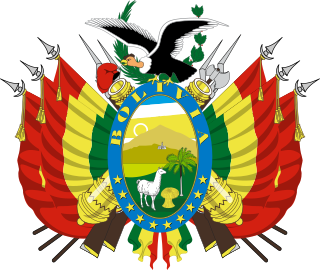 W
WThe Andean condor is a South American bird in the New World vulture family Cathartidae and is the only member of the genus Vultur. Found in the Andes mountains and adjacent Pacific coasts of western South America, the Andean condor is the largest flying bird in the world by combined measurement of weight and wingspan. It has a maximum wingspan of 3.3 m and weight of 15 kg (33 lb). It is generally considered as the largest bird of prey in the world.
 W
WCantua buxifolia,, known as qantu, qantus or qantuta (Quechua,) is a flowering plant found in the high valleys of the Yungas of the Andes mountains in western South America. Also known as the Peruvian magic tree, it is an evergreen shrub growing to 4 m (13 ft) tall by 2.5 m (8.2 ft) wide with small leaves and clusters of brilliant pink, narrow tubular flowers in early spring.
 W
WThe coat of arms of Bolivia has a central cartouche surrounded by Bolivian flags, cannons, laurel branches, and has an Andean condor on top.
 W
WThe flag of Bolivia is the national flag of the Plurinational State of Bolivia. It was originally adopted in 1851. The state and war flag is a horizontal tricolor of red, yellow and green with the Bolivian coat of arms in the center. According to one source, the red stands for Bolivia's brave soldiers, while the green symbolizes fertility and yellow the nation's mineral deposits. Along with the Dominican Republic, Haiti, Ecuador, Costa Rica, Venezuela, and El Salvador it is one of eight national flags in the world which has a depiction of its flag within the flag itself. It is one of four national flags among UN member states that features a firearm, along with those of Mozambique, Haiti and Guatemala.
 W
WThe flag of the Patujú flower is a flag used in official acts of the Bolivia government, which shows Bolivia's national flower. The latter represents the indigenous peoples of Eastern Bolivia and has been used as a symbol of protest by the opponents of Evo Morales in that area of the country.
 W
WHeliconia rostrata, the hanging lobster claw or false bird of paradise, is a herbaceous perennial plant native to Peru, Bolivia, Colombia, Venezuela, Costa Rica, and Ecuador, and naturalized in Puerto Rico. Other heliconias grow in an upright position, their cup-shaped flower bracts storing water for birds and insects. This plant, however, has downward-facing flowers, the flowers thus providing a source of nectar to birds.
 W
WThe Wiphala is a square emblem commonly used as a flag to represent some native peoples of the Andes that include today's Peru, Bolivia, and parts of Ecuador, Argentina, Chile and Colombia.